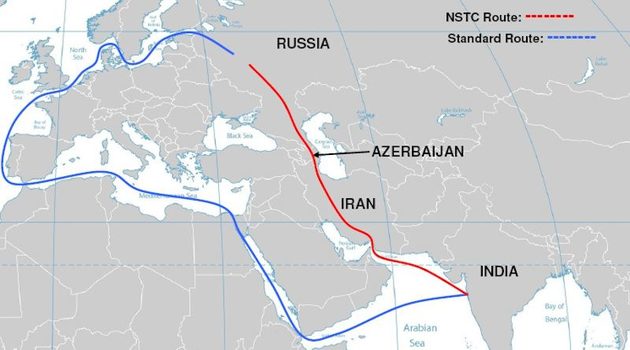The International North-South Transport Corridor (INSTC) is a 7,200-km-long multi-mode transport project for moving freight among India, Iran, Afghanistan, Armenia, Russia, Belarus, Bulgaria, Kazakhstan, Kyrgyz Republic, Oman, Syrian Arab Republic, Tajikistan, Turkey, Ukraine. It is going to be a strategic significant connectivity project in Central Asia and Europe, Eurasia Review writes.
It is not a new concept. But the current INSTC project was initiated by Russia, India and Iran in September 2000 in St. Petersburg. The agreement was signed on 16th May 2002. Now all parties specially India, Iran and Russia are working to come into force.
The International North-South Transport Corridor connects Mumbai to Moscow and passes through Iran and Azerbaijan. India is very interested to include Iran's Chabahar port to facilitate the connectivity project.
According to the Indian Foreign Ministry, Enhancing connectivity The International North South Transport Corridor to facilitate transportation of goods and improve trading links between India, Russia and Iran.
The International North-South Transport Corridor will reduce the time and cost of delivering goods by more than 40 percent in comparison with the Suez Canal. Russian and India Foreign Ministers assessed the economic cooperation noting new opportunities in the Russian far east. They spoke of connectivity including the International North-South Transport Corridor and Chennai-Vladivostok Maritime Corridor during the Russian Foreign Minister Sergei Lavrov’s visit to India in April.
At a connectivity conference in Tashkent in July, External Affairs Minister S Jaishankar projected Iran’s Chabahar port as a key regional transit hub including to Afghanistan, suggesting inclusion of this port with the connectivity project.
Media reports say India has proposed to include the Chabahar port in the framework of the International North-South Transport Corridor (INSTC) and has welcomed the formation of the India-Uzbekistan-Iran-Afghanistan Quadrilateral Working Group on the joint use of Chabahar port. A meeting of the joint group is likely to be held under a quadrilateral framework later this year on joint use of the port.
The main objectives of the project is to revive the ancient transport routes and connect the Indian ocean to the Persian gulf to the Caspian sea. It is going to a shorter passage between Russia and India via Iran and Central Asian states. This creates the opportunity for Bangladesh.
There are some prospects and potentials for Bangladesh utilizing the connectivity project. Bangladesh is a neighboring country of India. They have a linkage between Indian ports and Bangladeshi ports. The ports of Bangladesh can be connected with this project via Mumbai – Chennai port and Iran’s Chabahar port. The relations between Bangladesh and India are most brotherly. Chittagong port and Mongla port can be connected directly with the project for the maximization of the country’s interest.
Now connectivity is very essential for every state in the world. As a rising economic star in South Asia, Bangladesh can participate in the project for it’s own business interest. Many renowned economists describe it as a South Asian economic miracle. The current ruling party, Bangladesh Awami League is trying its level best to make the country socio-economically prosperous under the leadership of it’s premier Sheikh Hasina.
Bangladesh and Central Asia can be connected through this route. There is a huge market waiting for Bangladeshi products. Bangladesh’ garments sector is rising. It needs cotton. Bangladesh can easily import cotton from Central Asian states, wheat from Russia, seek investment from these states and export it’s leather, apparel and potato to Central Asian states, Eurasian states, Russia.
Bangladesh would be able to increase its export to Iran and seek investment from Iran. using it’s Chabahar port. Although Iran and Russia suffer US sanctions. However, India can help Bangladesh in this regard. As a peace lover and peace keeper country, Bangladesh would like it’s relations with every state. ‘Friendship to all, Malice to none’ is it’s foundation of foreign policy. Bangladesh’ s target is to become a developed country. So it needs a developing partner.
We know the ongoing Afghan crisis. Bangladesh can take part in the development process (Socio-economic-infrastructural) in Afghanistan if the situation is normal and stagnant. This connectivity project will pave the way. Bangladesh would like to play its role to ensure regional stability.
Bangladesh Foreign Minister Dr AK Abdul Momen attended the international conference titled “Central and South Asia: Regional Connectivity – Challenges and Opportunities” which was held in Tashkent, Uzbekistan in July.
Combined efforts among all states to establish good connectivity in Central and South Asia can open new avenues of cooperation.
Bangladesh has tried to boost the connectivity with its neighboring countries and playing a leading role through the organisation called the Bay of Bengal Initiative for Multi-Sectoral Technical and Economic Cooperation (BIMTEC), initiating to connect Bangladesh with Bhutan, India, Sri Lanka, Thailand, Nepal, and Myanmar with the ASEAN.
Bangladesh is also trying to engage herself in various connectivity projects through road, rail, and sea routes with the neighboring countries' cooperation.
In the modern world, there is no alternative without connectivity amongst states. A new potential is waiting for Bangladesh to be a partner of this project. The International North South Transport corridor creates and brings opportunities for Bangladesh. Bangladesh can connect itself with the Central and West Asian countries.






